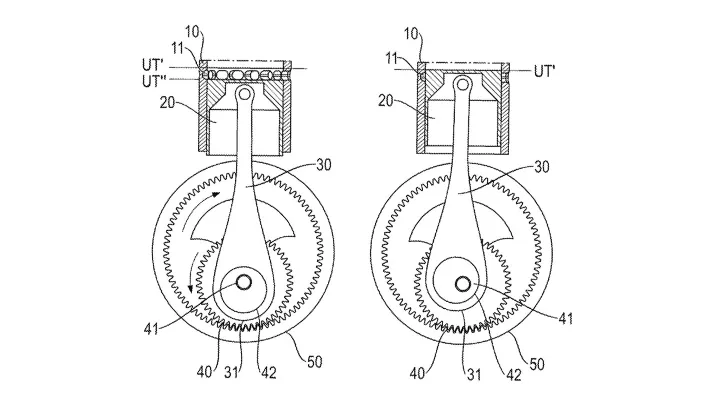Porsche unveiled a groundbreaking concept, redefining internal combustion engines. The iconic automaker filed a patent for a six-stroke combustion engine, signaling a bold step toward enhanced efficiency and power.
This innovation could become a game-changer in an era where electric vehicles gain momentum.
Understanding the Traditional Four-Stroke Engine
Before diving into Porsche’s innovation, it’s essential to grasp how conventional engines operate. Most combustion engines use a four-stroke cycle:
- Intake Stroke: The piston moves down, allowing a mixture of air and fuel to enter the cylinder.
- Compression Stroke: The piston moves up, compressing the air-fuel mixture.
- Power Stroke: The spark plug ignites the compressed mixture, pushing the piston down and generating power.
- Exhaust Stroke: The piston moves up again, expelling combustion gases through the exhaust valve.
In this cycle, only one of four strokes produces power. This limitation drives engineers to seek ways to enhance efficiency without sacrificing performance.

Introducing the Six-Stroke Engine Concept
Porsche’s six-stroke engine adds two strokes to the traditional cycle. The engine operates in two sequences of three strokes each:
- First Sequence: Intake, compression, and power.
- Second Sequence: Compression, power, and exhaust.
This design means the engine generates power during two strokes instead of one. By doubling the power strokes, Porsche aims to improve engine efficiency and performance.
The Mechanics Behind the Innovation
The key to this six-stroke engine lies in its unique crankshaft design. Porsche’s patent describes a crankshaft spinning on an annulus—a ring with two concentric circles. This configuration allows the engine to have two top dead centers (TDC) and two bottom dead centers (BDC).
Here’s how it works:
- Variable Piston Travel: The annulus mechanism alters the piston’s travel distance. During certain strokes, the piston doesn’t move as far up or down, effectively changing the compression ratio.
- Additional Compression and Power Strokes: The varying piston travel enables the extra compression and power strokes without adding cylinders or increasing engine size.
By manipulating piston movement, Porsche introduces the additional strokes seamlessly into the engine cycle.
Potential Benefits of the Six-Stroke Engine
- Increased Power OutputWith two power strokes in each cycle, the engine produces more power without increasing size. This efficiency could result in better performance and acceleration.
- Enhanced Fuel EfficiencyMore power strokes mean the engine extracts more energy from the same amount of fuel. This efficiency could lead to better fuel economy, a significant advantage given rising fuel costs.
- Reduced EmissionsBy burning the air-fuel mixture more thoroughly, the engine produces fewer emissions. This improvement aligns with global efforts to reduce the environmental impact of combustion engines.
- Optimized CombustionThe additional compression and power strokes allow for a more complete combustion process. This optimization can reduce unburned fuel and improve overall engine efficiency.
Challenges and Considerations
While the six-stroke engine offers promising benefits, it also presents several challenges:
- Mechanical ComplexityThe intricate crankshaft design and additional strokes increase the engine’s complexity. This complexity could lead to higher production costs and potential reliability issues.
- Manufacturing CostsSpecialized components and precise engineering are required for this design. These factors could make the engine more expensive to produce compared to traditional engines.
- Maintenance and RepairThe unique design may require specialized maintenance procedures. Repairing such an engine could be more costly and require technicians with specific expertise.
- Market AcceptanceConvincing consumers and industry stakeholders to adopt a new engine technology can be challenging. The benefits must outweigh the costs and potential risks for widespread acceptance.

Implications in the Current Automotive Landscape
The automotive industry experiences a significant shift toward electrification. Governments and regulators worldwide implement stricter emissions standards and promote electric vehicles (EVs). In this context, Porsche’s six-stroke engine represents an alternative approach to improving efficiency within traditional combustion technology.
- Prolonging the Viability of Combustion EnginesBy enhancing efficiency and reducing emissions, the six-stroke engine extends the relevance of combustion engines. This development provides an option for consumers and markets still transitioning to electric vehicles.
- Complementing Hybrid SystemsThe six-stroke engine could integrate into hybrid systems, combining improved combustion efficiency with electric power. This synergy offers high performance with lower environmental impact.
- Competitive EdgeFor luxury and performance brands like Porsche, maintaining combustion engine innovation is crucial. The unique driving experience provided by combustion engines remains a selling point for many customers.
The Road Ahead: Will the Six-Stroke Engine See Production?
While the patent filing indicates serious research and development efforts, it’s uncertain whether the six-stroke engine will reach production. Several factors will influence this outcome:
- Feasibility StudiesExtensive testing is required to validate engine performance, reliability, and efficiency gains. These studies will determine if theoretical benefits hold up under real-world conditions.
- Regulatory ComplianceThe engine must meet stringent emissions and safety regulations in various markets. Compliance adds another layer of complexity to the development process.
- Economic ViabilityCosts associated with producing and maintaining the engine must be justifiable. If the engine proves too expensive, it may not become a practical option for consumers or the company.
- Market DemandConsumer preferences are shifting toward electric vehicles. Porsche must assess whether there’s sufficient demand for an advanced combustion engine in the evolving market.
Conclusion: A Bold Step Toward Engine Innovation
Porsche’s six-stroke engine patent showcases the company’s commitment to pushing the boundaries of automotive engineering. By reimagining the fundamental operation of combustion engines, Porsche aims to deliver enhanced performance and efficiency.
This innovation could have significant implications for the industry:
- Setting New StandardsIf successful, the six-stroke engine could set new benchmarks for efficiency and power in combustion engines.
- Stimulating CompetitionOther manufacturers may pursue similar innovations, leading to a new wave of engine development.
- Providing AlternativesFor markets and consumers still transitioning to full electrification, advanced combustion engines offer a viable alternative.
Final Thoughts
The six-stroke engine represents a fusion of traditional engineering and innovative thinking. Porsche’s pursuit of this technology reflects a dedication to excellence and a willingness to challenge conventions.
As the automotive world moves toward an electric future, innovations like the six-stroke engine remind us multiple paths exist to achieve efficiency and performance.
Whether this engine becomes a reality remains to be seen, but its conception is a testament to human ingenuity and the relentless quest for advancement.




































